What is ERC-721? A Guide to the Ethereum NFT Token Standard
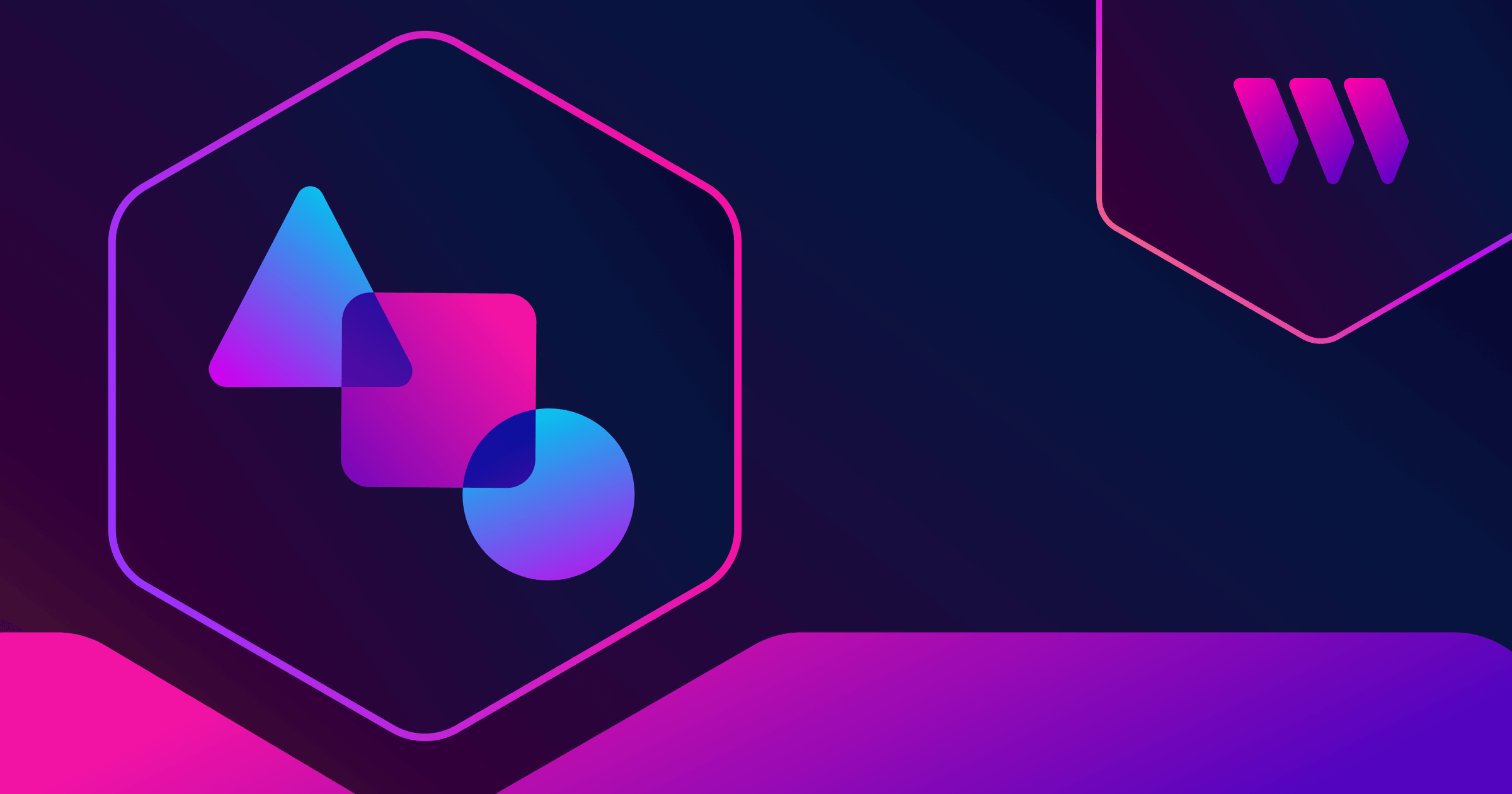
With the rise of web3, the ERC-721 smart contract standard has gained lots of popularity due to its applications for non-fungible tokens (or NFTs). The importance of ERC-721 has grown rapidly, with NFTs becoming increasingly popular in various industries.
The ERC-721 smart contract standard provides a template for creating unique tokens on the Ethereum blockchain. These tokens, known as NFTs, are used to represent unique digital or physical assets and have opened up new opportunities in the world of digital ownership and content creation.
In this blog post, we’re going to demystify everything you need to know about the ERC-721 token standard. We’ll cover what ERC-721 is, the use cases for ERC-721 in NFTs, and how you can get started with ERC-721 NFTs and smart contracts. Let’s dive in.
What is ERC-721?
ERC-721 is a non-fungible token standard on the Ethereum blockchain. It provides a set of guidelines for creating unique tokens that represent digital assets. These tokens are non-fungible, meaning that they cannot be exchanged on a one-to-one basis due to their unique properties.
The importance of ERC-721 lies in its ability to facilitate the creation of NFTs, which have a wide range of applications in gaming, art, collectibles, and more. The standard allows for the secure transfer and ownership of these unique assets.
In the context of Web3, ERC-721 provides a framework for creating decentralized applications (dApps) that utilize NFTs for various purposes, from virtual worlds to decentralized finance (DeFi) platforms.
How does the ERC-721 standard work?
The ERC-721 standard consists of a set of functions that developers can implement in their smart contracts to create, transfer, and manage NFTs. These functions allow for the creation of unique tokens with their own metadata, making them distinguishable from one another.
Under the hood, ERC-721 smart contracts maintain a record of token ownership, allowing for the secure transfer of tokens between users. The contract also keeps track of the total supply of tokens and the balance of tokens owned by individual addresses.
You can learn more about the technical details in Ethereum’s EIP docs.
Benefits of ERC-721 for NFTs
The ERC-721 token standard offers several benefits for unique digital assets in the form of NFTs:
- Ownership: ERC-721 allows users to own, transfer, and manage unique digital assets securely, with transparent and verifiable ownership records.
- Interoperability: The standard ensures that NFTs can easily interact with various marketplaces, wallets, and dApps on the Ethereum network, enhancing their utility and accessibility.
- Rarity and uniqueness: Unlike fungible tokens, ERC-721 NFTs represent distinct items with unique properties, making them valuable for collectors and creators alike.
- Programmability: The ERC-721 standard enables creators to build additional functionalities into their NFTs, such as royalties for artists, in-game utilities, or evolving attributes.
- Digital scarcity: With a limited supply and transparent provenance, ERC-721 NFTs establish digital scarcity, which can contribute to their long-term value.
- Intellectual property rights: ERC-721 NFTs can help protect intellectual property by providing artists and creators with an immutable record of their work, along with a means of tracking usage and resale.
- Fractional Ownership: NFTs built on the ERC-721 standard can be divided into smaller, tradable fractions, enabling a wider audience to invest in high-value assets.
- Cross-platform compatibility: The Ethereum-based ERC-721 standard enables NFTs to be used across different platforms and applications, broadening their potential use cases.
With all of the above benefits, the ERC-721 token standard is very powerful when it comes to NFTs — and unlocks various use cases across art, gaming, and industries across the board. Let's dive into some of those applications.
8 Use Cases for ERC-721 NFTs
Now that we understand the basics of the ERC-721 standard, let's dive into its various use cases and applications in the world of blockchain and Web3.
- Gaming: ERC-721 tokens are widely used in blockchain-based games, where each in-game asset is unique and can be traded, sold, or bought by players. Examples include Axie Infinity, and Gods Unchained.
- Digital Art and Collectibles: NFTs have revolutionized the digital art industry by providing artists with a way to monetize their work through unique tokens. Platforms like OpenSea, Rarible, and Art Blocks allow artists to create and sell their artwork as NFTs using the ERC-721 standard.
- Virtual Worlds: ERC-721 tokens are used to represent land parcels, buildings, and other assets in virtual worlds like Decentraland and The Sandbox. Users can buy, sell, and trade these assets in open marketplaces.
- Domain Names: Projects like the Ethereum Name Service (ENS) and Unstoppable Domains use ERC-721 tokens to represent domain names on the blockchain, enabling users to have decentralized and censorship-resistant domain names. Social platforms like Lens Protocol also use ERC-721 tokens for usernames on the protocol.
- Event Ticketing: ERC-721 tokens can be used to create unique tickets for events such as concerts, conferences, and sports matches. Each ticket is represented by a unique token, making it secure and easily transferable between users.
- Music and Media: Musicians and other content creators can use ERC-721 tokens to tokenize their work, allowing fans to purchase and own unique pieces of content, such as limited edition albums, videos, or exclusive merchandise. They can also do this through platforms like EVEN.
- Identity and Certification: ERC-721 tokens can be used to represent digital identities, educational certificates, or professional licenses, enabling secure and tamper-proof storage of important credentials on the blockchain.
- DeFi and Financial Instruments: In the world of decentralized finance (DeFi), ERC-721 tokens can be used to create unique financial instruments, such as tokenized real estate, insurance policies, or bonds, allowing for greater flexibility and innovation in the financial sector.
List of 10 Popular ERC-721 NFT Projects
The majority of NFT projects are built on the ERC-721 standard. Some of the most popular examples include:
- CryptoPunks
- Bored Ape Yacht Club
- CryptoKitties
- Nike’s RTFKT
- Doodles
- The Sandbox
- Decentraland
- Axie Infinity
- Gods Unchained
- NBA Topshot
- Art Blocks
You can explore all of the above smart contracts and use them for your own projects by searching for the contract name or address in the thirdweb dashboard:
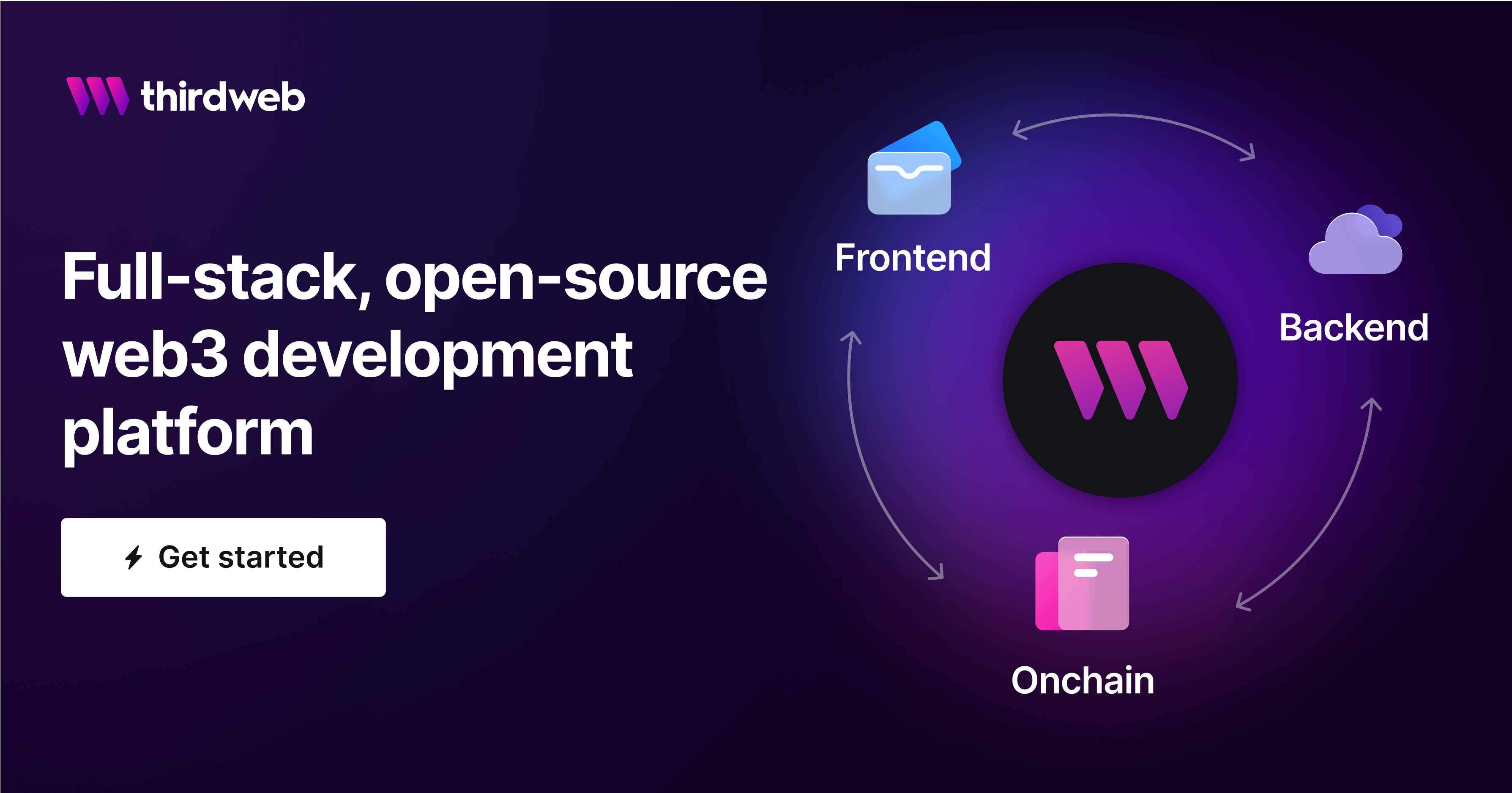
How to create an ERC-721 NFT smart contract
Creating an ERC-721 NFT typically requires writing, testing, and deploying a smart contract using the Solidity programming language.
Alternatively, you can use thirdweb Explore — a library of open-source, pre-built audited smart contracts for various use cases, with extensions & features based on your needs, all deployable in minutes:
NFT Drop
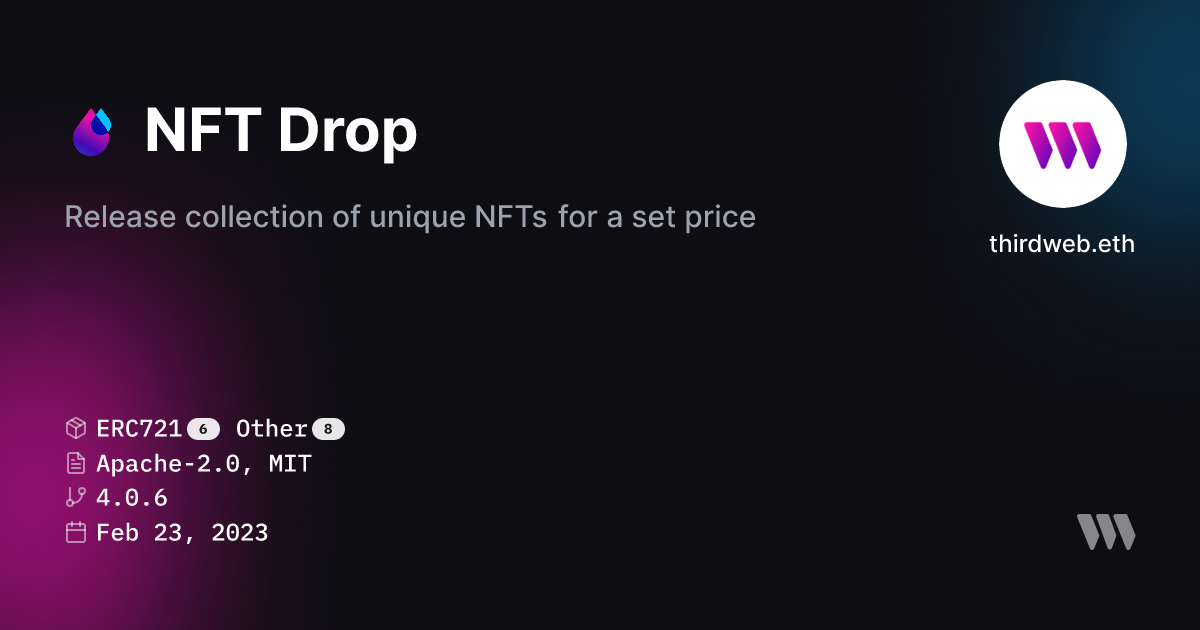
The NFT Drop contract is ideal when you want to release a collection of unique NFTs using the ERC721A Standard.
It allows you to define a set of conditions called claim phases in a sequence which defines when and how your users can claim an NFT from your drop; including allowlists, release dates, claim limits, and delayed reveals.
When you add NFTs to your drop contract, they are not minted at this point. You prepare everything for your users by lazy minting them, so that other wallets can mint them.
Use Cases & Examples
- Release a PFP Collection where each NFT has a different combination of traits
- Release NFTs of your artwork, and have your community mint them for a price
- Create a restricted-access NFT drop, where only a specified list of wallets can claim NFTs
NFT Collection
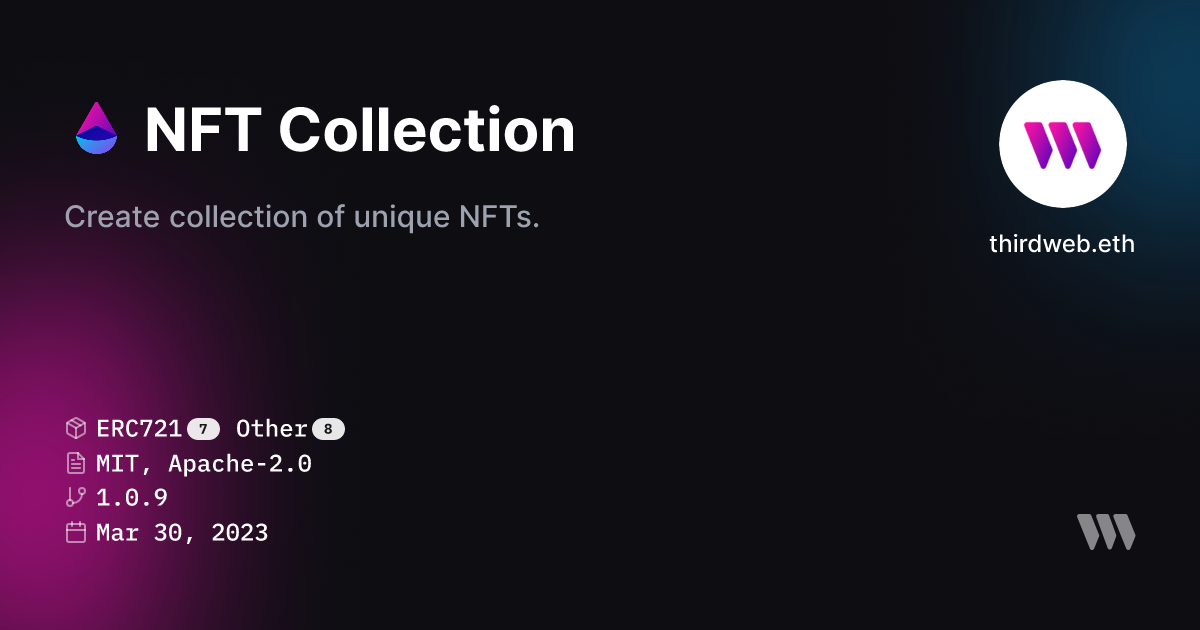
The NFT Collection contract is suitable for when you want to have a collection of unique NFTs, but not "drop" or "release" them for your community to claim.
Unlike the NFT Drop contract, the NFT Collection contract does not lazy mint your NFTs. Instead, NFTs are minted immediately when they are added to the collection.
This means you can still transfer the NFTs or sell them on a Marketplace and perform any other actions you would expect to do with an NFT.
For advanced use-cases, the NFT Collection also has signature-based minting capabilities.
Use Cases & Examples
- Create a 1-of-many collection of your photography
- Create a 1-of-1 NFT that provides special utility
- Mint your artwork as NFTs and then sell them on a Marketplace
- Create a community-made NFT collection
Membership
The Membership smart contract from Unlock Protocol lets you create recurring subscriptions, tickets, certifications, and more types of ERC-721 NFTs with time-bound properties.
Use Cases & Examples
- Set expiration dates for each NFT membership
- Airdrop and sell membership NFTs from the contract
- Create a free or paid membership program for your community or ecosystem
- Generate recurring subscription revenue
- Deploy a ticketing system for events
- Customize the visual aspect of each membership NFT
- Extend the behavior of the contract with hooks
NFT Staking
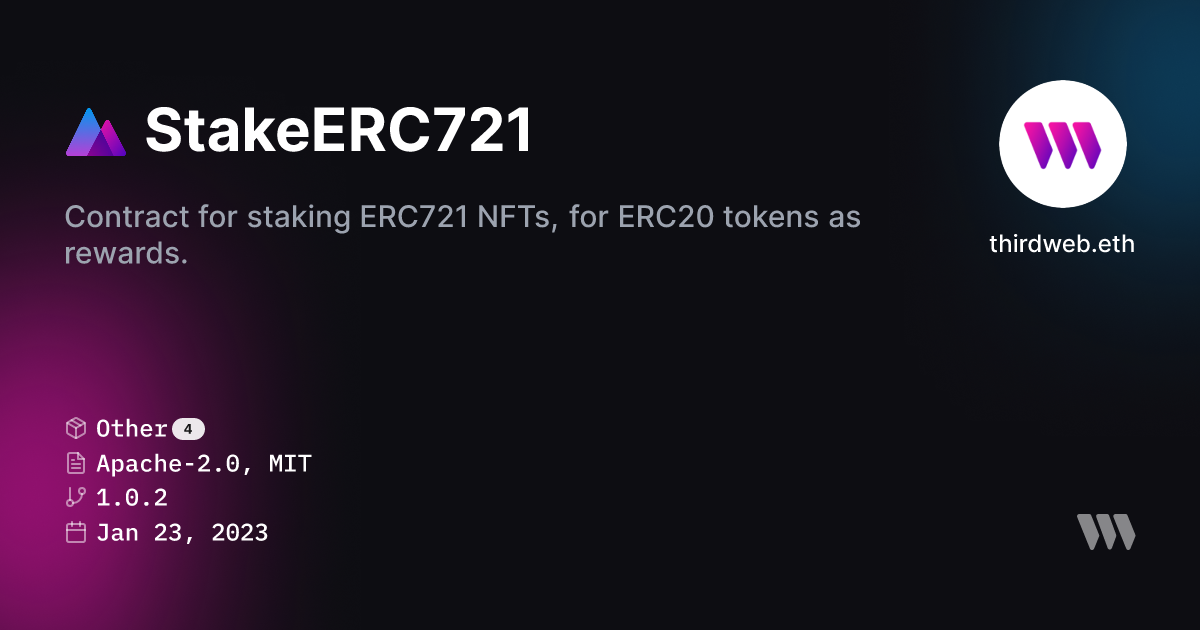
This contract allows users to stake their ERC-721 NFTs and get ERC-20 tokens as staking rewards. Contract admin should set the NFT and Reward-token addresses during deployment. These can't be changed later.
Staked NFTs are stored inside the contract and rewards are calculated for the amount of time these NFTs were staked. Admin should maintain adequate balance of reward tokens in the staking-contract. These rewards are then transferred to stakers upon claiming.
These ERC-721 smart contracts showcase the versatility and potential of the NFT standard in the Web3 ecosystem. By leveraging these contracts, developers can create innovative solutions and unlock new use cases for non-fungible tokens.
Concluding thoughts: The future of ERC-721 NFTs
As the popularity of NFTs continues to grow, the ERC-721 standard plays a crucial role in the development and adoption of new applications and use cases. With the expansion of the Web3 ecosystem, we can expect to see an increasing number of projects leveraging the unique properties of ERC-721 tokens to bring innovative solutions to various industries.
The ERC-721 smart contract standard has revolutionized the concept of digital ownership and paved the way for the creation of unique digital assets in the form of NFTs. Its wide range of applications in gaming, art, virtual worlds, and beyond demonstrates its relevance and importance in the rapidly evolving world of web3.
The continuous improvement and development of the Ethereum network will result in the emergence of new and enhanced token standards (like ERC721A), offering even more functionality and possibilities for NFT creators and users. As the ecosystem continues to grow and mature, we can expect ERC-721 and NFTs to play a significant role in shaping the future of digital ownership and content creation.
We hope this blog post has helped you better understand what the ERC-721 NFT standard is, what its use cases are on the blockchain, and how you can get started with ERC-721 smart contracts.
If you have any questions, join 33,000+ other builders in our Discord community — or reach out to the team directly for more info on how to get started with ERC-721.
And if you want to start building web3 apps with ERC-721 smart contracts, get started with thirdweb’s web3 tools & SDKs — they’re free!

